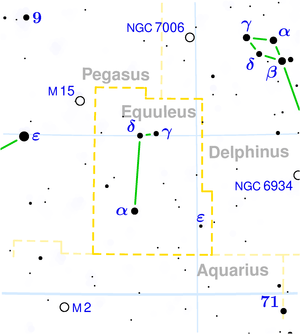|
|
Equuleus ( Latin: little horse, i.e. a foal) is the second smallest of the 88 modern constellations, only Crux being smaller. Despite its smallness and lack of bright stars (none is brighter than fourth magnitude), it was also one of Ptolemy's 48 constellations. Notable features Equuleus is the second smallest constellation, at 72 square degrees. The only constellation that is smaller is Crux. It is not a particularly conspicuous constellation; its brightest star is α Equ (Kitalpha), at magnitude 3.92m. There are few variable stars in Equuleus. Only around 25 are known, most of which are obscure. γ Equ is an alpha CVn star, ranging between magnitudes 4.58m and 4.77m over a period of around 12½ minutes. R Equ is a Mira variable that ranges between magnitudes 8.0m and 15.7m over nearly 261 days. Equuleus contains some double stars of interest. γ Equ consists of a primary star with a magnitude around 4.7m (slightly variable) and a secondary star of magnitude 11.6, separated by 2 arcseconds. ε Equ consists of four components. The brightest three are of magnitudes 6.0m, 6.3m, and 7.2m. δ Equ is a binary star with an orbital period of 5.7 years, which at one time was the shortest known orbital period for an optical binary. The two components of the system are never more than 0.35 arcseconds apart. Notable deep sky objects Due to its small size and its distance from the plane of the Milky Way, Equuleus contains no notable deep sky objects. Some very faint galaxies between magnitudes 13 and 15 include NGC 7015, NGC 7040, NGC 7045 and NGC 7046. Mythology Equuleus is associated with the foal Celeris (meaning "swiftness" or "speed"), who was the offspring or brother of the winged horse Pegasus. Celeris was given to Castor by Mercury. Some myths say that Equuleus is the horse struck from Neptune's trident, during the contest between him and Athena when deciding which would be the superior. Because this section of stars rises before Pegasus, it is often called Equus Primus, or the First Horse. Equuleus is also linked to the story of Philyra and Saturn. References * Burnham, Robert (1978). Burnham's Celestial Handbook: An observer's guide to the universe beyond the solar system, vol 2. Dover Publications ISBN 0-486-23567-X * Hoffleit+ (1991) V/50 The Bright Star Catalogue, 5th revised ed, Yale University Observatory, Strasbourg astronomical Data Center * Ian Ridpath and Wil Tirion (2007). Stars and Planets Guide Links
Retrieved from "http://en.wikipedia.org/"
|
|
||||||||||||||||||||||||||||||||||||||||||||||||||||
